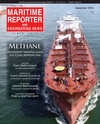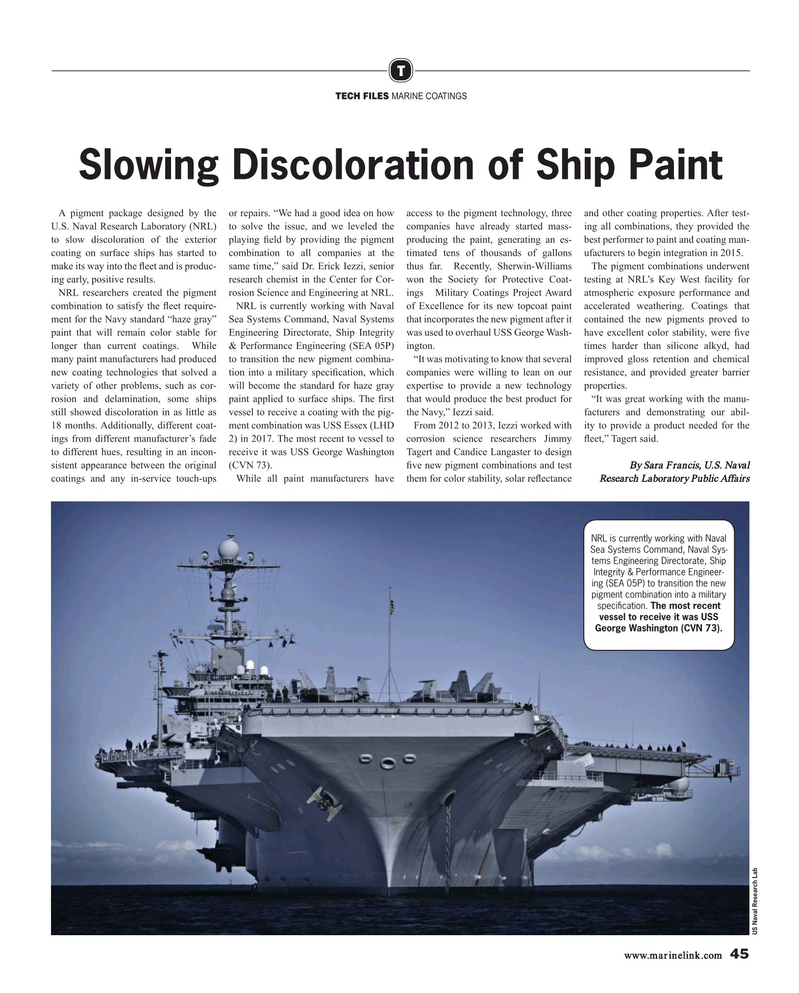
Page 45: of Maritime Reporter Magazine (September 2019)
Satellite Communications
Read this page in Pdf, Flash or Html5 edition of September 2019 Maritime Reporter Magazine
T
TECH FILES MARINE COATINGS
Slowing Discoloration of Ship Paint
A pigment package designed by the or repairs. “We had a good idea on how access to the pigment technology, three and other coating properties. After test-
U.S. Naval Research Laboratory (NRL) to solve the issue, and we leveled the companies have already started mass- ing all combinations, they provided the to slow discoloration of the exterior playing ? eld by providing the pigment producing the paint, generating an es- best performer to paint and coating man- coating on surface ships has started to combination to all companies at the timated tens of thousands of gallons ufacturers to begin integration in 2015.
make its way into the ? eet and is produc- same time,” said Dr. Erick Iezzi, senior thus far. Recently, Sherwin-Williams The pigment combinations underwent ing early, positive results. research chemist in the Center for Cor- won the Society for Protective Coat- testing at NRL’s Key West facility for
NRL researchers created the pigment rosion Science and Engineering at NRL. ings Military Coatings Project Award atmospheric exposure performance and combination to satisfy the ? eet require- NRL is currently working with Naval of Excellence for its new topcoat paint accelerated weathering. Coatings that ment for the Navy standard “haze gray” Sea Systems Command, Naval Systems that incorporates the new pigment after it contained the new pigments proved to paint that will remain color stable for Engineering Directorate, Ship Integrity was used to overhaul USS George Wash- have excellent color stability, were ? ve longer than current coatings. While & Performance Engineering (SEA 05P) ington. times harder than silicone alkyd, had many paint manufacturers had produced to transition the new pigment combina- “It was motivating to know that several improved gloss retention and chemical new coating technologies that solved a tion into a military speci? cation, which companies were willing to lean on our resistance, and provided greater barrier variety of other problems, such as cor- will become the standard for haze gray expertise to provide a new technology properties. rosion and delamination, some ships paint applied to surface ships. The ? rst that would produce the best product for “It was great working with the manu- still showed discoloration in as little as vessel to receive a coating with the pig- the Navy,” Iezzi said. facturers and demonstrating our abil- 18 months. Additionally, different coat- ment combination was USS Essex (LHD From 2012 to 2013, Iezzi worked with ity to provide a product needed for the ings from different manufacturer’s fade 2) in 2017. The most recent to vessel to corrosion science researchers Jimmy ? eet,” Tagert said.
to different hues, resulting in an incon- receive it was USS George Washington Tagert and Candice Langaster to design sistent appearance between the original (CVN 73). ? ve new pigment combinations and test By Sara Francis, U.S. Naval coatings and any in-service touch-ups While all paint manufacturers have them for color stability, solar re? ectance Research Laboratory Public Affairs
NRL is currently working with Naval
Sea Systems Command, Naval Sys- tems Engineering Directorate, Ship
Integrity & Performance Engineer- ing (SEA 05P) to transition the new pigment combination into a military speci? cation. The most recent vessel to receive it was USS
George Washington (CVN 73).
US Naval Research Lab www.marinelink.com 45
MR #9 (42-49).indd 45 MR #9 (42-49).indd 45 9/12/2019 11:38:07 AM9/12/2019 11:38:07 AM

 44
44

 46
46
